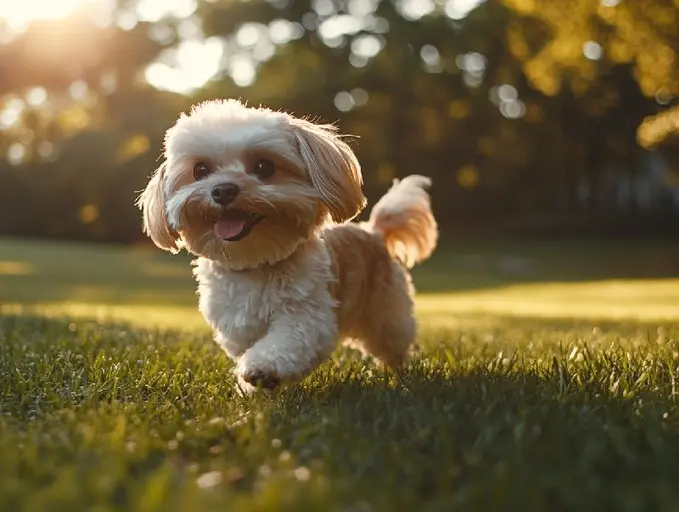Discover the Havanese: A Comprehensive Guide to This Charming Companion

A Brief Introduction to the Havanese
The Havanese, Cuba’s only native dog breed, is a small, sturdy, and charming companion known for its intelligence, playful personality, and distinctive silky coat. They are often described as happy-go-lucky dogs that thrive on human interaction, making them excellent family pets. Their adaptable nature and eagerness to please also make them relatively easy to train. The breed’s captivating appearance, coupled with their sunny disposition, makes them a popular choice for individuals and families alike.
The History of the Breed
Cuban Origins and Aristocratic Roots
The Havanese’s history is intertwined with the history of Cuba. Their ancestors are believed to have been brought to Cuba by Spanish traders and settlers sometime in the 16th or 17th century. These early dogs, likely related to the Bichon family from the Mediterranean region, were then refined and developed in Cuba.
Initially, these dogs became popular among the Cuban aristocracy and wealthy planters. They were cherished as lap dogs and companions, receiving pampered care and attention. This pampered lifestyle contributed to the breed’s development of a gentle and affectionate temperament.
From Luxury to Near Extinction and Back
During the Cuban Revolution in the 1950s, many wealthy Cuban families fled the country, and some took their Havanese with them. This proved crucial for the breed’s survival. While the breed nearly disappeared in Cuba, a small number of Havanese survived in the United States.
Through dedicated breeding efforts, these few dogs became the foundation for re-establishing the breed. Today, the Havanese is a thriving breed, recognized by major kennel clubs worldwide and beloved for its charming personality and adaptable nature. So, despite almost disappearing they made a successful comeback.
Appearance
Size and Build
- Height: The Havanese typically stands between 8.5 and 11.5 inches tall at the shoulder.
- Weight: They generally weigh between 7 and 13 pounds.
- Build: They are small and sturdy, with a well-balanced and compact body.
Coat and Color
- Coat: The Havanese’s most distinctive feature is its long, silky, and profuse coat. It is soft to the touch and can be slightly wavy or curly. A hallmark of this breed is the profusion of hair.
- Color: The Havanese coat comes in a wide variety of colors, including:
- White
- Cream
- Black
- Brown
- Gray
- Sable
- And various combinations of these colors
Head and Facial Features
- Head: The head is moderately sized and in proportion to the body. They have a broad skull.
- Eyes: Their eyes are dark brown, almond-shaped, and expressive, conveying intelligence and affection.
- Ears: The ears are drop ears, folded and hanging down the sides of the head. They are covered in long, silky fur.
- Muzzle: The muzzle is of medium length and tapers slightly to the nose.
- Nose: Their nose is black or brown, depending on the coat color.
Tail
The tail is set high and carried arched over the back, with a plume of long, silky fur. This distinctive tail carriage adds to the breed’s charming appearance.
Character and Behavior
Temperament and Personality
The Havanese is known for its playful, affectionate, and intelligent nature. They are very social dogs and thrive on human companionship. They are often described as “Velcro dogs” because they tend to stick close to their owners.
Attitude Towards People and Children
Havanese are generally good with people of all ages, including children. Their playful and gentle nature makes them excellent family pets. However, due to their small size, it’s essential to supervise interactions with very young children to prevent accidental injuries.
Relationship with Other Animals
Havanese typically get along well with other dogs and even cats, especially if they are socialized from a young age. Their friendly and adaptable nature makes them relatively easy to integrate into multi-pet households.
Activity Level and Exercise Needs
While Havanese are not high-energy dogs, they still require regular exercise to stay healthy and happy. A daily walk, playtime in the park, or interactive games indoors will usually suffice. Their small size makes them well-suited for apartment living, as long as their exercise needs are met.
Trainability and Intelligence
Havanese are intelligent and eager to please, which makes them relatively easy to train. They respond well to positive reinforcement methods, such as treats, praise, and toys. Their intelligence and trainability also make them good candidates for dog sports, such as agility and obedience.
Breed Characteristics and Quirks
One of the Havanese’s most endearing quirks is their tendency to “shadow” their owners, following them from room to room. They are also known for their expressive eyes and playful antics, which can be quite entertaining.

Care and Maintenance
Grooming Needs
The Havanese’s long, silky coat requires regular grooming to prevent mats and tangles.
- Brushing: Daily brushing is recommended to keep the coat healthy and tangle-free. An undercoat rake can also be helpful for removing loose hair, especially during shedding seasons.
- Bathing: Regular bathing, every two to three weeks, is also necessary to maintain the coat’s cleanliness and shine.
- Haircuts: Some owners choose to keep the Havanese coat long and flowing, while others prefer to clip it shorter for easier maintenance. A “puppy cut” is a popular option, where the coat is trimmed to a shorter, more manageable length.
- Ear Cleaning: Regular ear cleaning is important to prevent ear infections.
- Nail Trimming: Nails should be trimmed regularly to prevent overgrowth and discomfort.
Exercise and Mental Stimulation
The Havanese benefits from daily exercise, even if it’s just a short walk or playtime in the backyard. Interactive games and puzzle toys can also provide mental stimulation and prevent boredom.
Feeding Requirements
A high-quality dog food formulated for small breeds is recommended. The amount of food will vary depending on the dog’s age, activity level, and metabolism. It’s important to avoid overfeeding, as the Havanese is prone to weight gain.
Health Considerations
The Havanese is generally a healthy breed, but like all breeds, they are prone to certain health problems. Some common health concerns include:
- Hip Dysplasia: A condition where the hip joint doesn’t develop properly.
- Elbow Dysplasia: Similar to hip dysplasia, but affecting the elbow joint.
- Legg-Calvé-Perthes Disease: A condition affecting the hip joint, causing the head of the femur to degenerate.
- Cataracts: Clouding of the lens of the eye.
- Progressive Retinal Atrophy (PRA): A degenerative eye disease that can lead to blindness.
- Patellar Luxation: A condition where the kneecap slips out of place.
- Heart Murmurs: These can be indicative of underlying heart conditions.
- Deafness: Some Havanese may experience congenital or age-related deafness.
Regular veterinary checkups and screening for these potential health problems can help ensure the dog’s overall well-being. Choosing a responsible breeder who screens their breeding dogs for these conditions is also crucial. Proper veterinary prevention is key.
Breed Weaknesses
Barking Tendencies
Havanese can be prone to excessive barking, especially if they are bored, anxious, or left alone for long periods. Training and early socialization can help mitigate this tendency.
Separation Anxiety
Due to their strong attachment to their owners, Havanese can be prone to separation anxiety if left alone for extended periods. Gradual acclimation to being alone and providing plenty of mental and physical stimulation can help prevent this issue.
Grooming Commitment
Their long, silky coat requires a significant time commitment to grooming. Owners must be prepared to brush their Havanese daily and provide regular baths to prevent mats and tangles.
Not known to be Aggressive
The Havanese is generally not an aggressive breed, but early socialization is still important to ensure that they are comfortable around strangers and other animals. Some individuals may be more reserved or cautious than others, but aggression is not typical of the breed.
Loyalty
Havanese are extremely loyal and form very strong bonds with their owners. This loyalty can sometimes lead to possessiveness or jealousy if not properly managed. Early training and socialization can help teach the dog to share attention and resources.
Conclusion
The Havanese is an ideal pet for individuals and families who are looking for a small, affectionate, and intelligent companion. They are relatively adaptable to different living situations, as long as their exercise and social needs are met. However, prospective owners should be prepared to commit to regular grooming and be aware of the breed’s potential for barking and separation anxiety. With proper care and attention, the Havanese can bring years of joy and companionship to its owner’s life. The Havanese truly earns its reputation as a charming and delightful dog breed.
Frequently Asked Questions About Havanese
-
What is a Havanese known for?
The Havanese is known for being a charming companion dog, its intelligence, playful personality, and distinctive silky coat. They are happy-go-lucky and thrive on human interaction.
-
How big do Havanese dogs get?
Havanese typically stand between 8.5 and 11.5 inches tall at the shoulder and generally weigh between 7 and 13 pounds.
-
Are Havanese dogs easy to train?
Yes, Havanese are intelligent and eager to please, making them relatively easy to train. They respond well to positive reinforcement methods.
-
Do Havanese dogs bark a lot?
Havanese can be prone to excessive barking, especially if they are bored or anxious. Training and early socialization can help mitigate this tendency.
-
What are the grooming needs of a Havanese?
The Havanese’s long, silky coat requires regular grooming. Daily brushing is recommended, and regular bathing is necessary. Some owners choose to keep the coat long, while others prefer to clip it shorter.
-
Are Havanese good with children?
Yes, Havanese are generally good with people of all ages, including children. Their playful and gentle nature makes them excellent family pets. Supervision is important with very young children.
-
Do Havanese dogs get along with other pets?
Havanese typically get along well with other dogs and even cats, especially if they are socialized from a young age.
-
What is the activity level of a Havanese?
While Havanese are not high-energy dogs, they still require regular exercise. A daily walk or playtime will usually suffice.
-
What are some common health problems in Havanese?
Some common health concerns include hip dysplasia, elbow dysplasia, Legg-Calvé-Perthes disease, cataracts, PRA, patellar luxation, heart murmurs and deafness.
-
Are Havanese prone to separation anxiety?
Yes, due to their strong attachment to their owners, Havanese can be prone to separation anxiety if left alone for extended periods.

